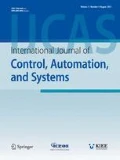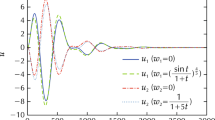Abstract
A new form of output feedback control, referred herein as explicit input and output feedback control (EIOC), is proposed for linear discrete-time systems. Unlike the conventional dynamic output feedback control described by a state-space model, the proposed EIOC has a batch form, where current control is explicitly expressed using current and past system outputs and past control inputs over a recent time horizon. The paper formulates the EIOC law and discusses its features and desirable characteristics. The EIOC is shown to be equivalent to static output feedback control for an augmented system. The coefficients of the EIOC are obtained to achieve the H ∞ performance criterion. Finally, numerical examples are presented to illustrate the effectiveness of the EIOC.
Similar content being viewed by others
References
P. Gahinet and P. Apkarian, “A linear matrix inequality approach to H ∞ control,” International Journal of Robust and Nonlinear Control, vol. 4, pp. 421–448, 1994.
L. E. Ghaoui, F. Oustry, and M. AitRami, “A cone complementary linearization algorithm for static output-feedback and related problems,” IEEE Trans. on Automatic Control, vol. 42, no. 8, pp. 1171–1176, 1997.
T. Iwasaki and R. E. Skelton, “A unified approach to fixed order controller design via linear matrix inequalities,” Mathematical Problems in Engineering, vol. 1, pp. 59–75, 1995.
W. H. Kwon, P. S. Kim, and S. H. Han, “A receding horizon unbiased FIR filter for discrete-time state space models,” Automatica, vol. 38, no. 3, pp. 545–551, 2002.
W. H. Kwon, P. S. Kim, and P. Park, “A receding horizon Kalman FIR filter for discrete time-invariant systems,” IEEE Trans. on Automatic Control, vol. 44, no. 9, pp. 1787–1791, 1999.
K. H. Lee, I. M. Boiko, and B. Huang, “Implementation of FIR control for H ∞ output feedback stabilization of linear systems,” Proc. of the American Control Conference, St. Louis, USA, June 10–12, 2009.
K. H. Lee, J. H. Lee, and W. H. Kwon, “Sufficient LMI conditions for H ∞ output feedback stabilization of linear discrete-time systems,” IEEE Trans. on Automatic Control, vol. 51, no. 4, pp. 675–680, 2006.
Y. S. Lee, S. H. Han, and W. H. Kwon, “H2 / H ∞ FIR filters for discrete-time state space models,” International Journal of Control, Automation, and Systems, vol. 4, no. 5, pp. 645–652, 2006.
M. Mattei, “Sufficient conditions for the synthesis of H ∞ fixed-order controllers,” International Journal of Robust and Nonlinear Control, vol. 10, pp. 1237–1248, 2000.
M. C. Oliveria, J. C. Geromel, and J. Bernussou, “Extended H2 and H ∞ norm characterization and controller parameterizations for discrete-time systems,” International Journal of Control, vol. 75, no. 9, pp. 666–679, 2002.
A. Saberi, P. Sannuti, and A. A. Stoorvogel, “H2 optimal controllers with measurement feedback for discrete-time systems: flexibility in closed-loop pole placement,” Automatica, vol. 33, no. 3, pp. 289–304, 1997.
C. Scherer, P. Gahinet, and M. Chilali, “Multiobjective output-feedback control via LMI optimization,” IEEE Trans. on Automatic Control, vol. 42, no. 7, pp. 896–911, 1997.
Y. S. Shamaliy, “Linear optimal FIR estimation of discrete time-invariant state-space models,” IEEE Trans. on Signal Processing, vol. 58, no. 6, pp. 3086–3096, 2010.
S. Xu, J. Lam, and C. Yang, “Robust H ∞ control for uncertain discrete singular systems with pole placement in a disk,” System and Control Letters, vol. 43, pp. 85–93, 2001.
Author information
Authors and Affiliations
Corresponding author
Additional information
Recommended by Editorial Board member Shengyuan Xu under the direction of Editor Myotaeg Lim.
This research was supported by an INHA Research Grant and was also supported by the MKE (The Ministry of Knowledge Economy), Korea, under the Industrial Convergence Technology Development Program (10040132) and the CITRC (Convergence Information Technology Research Center) support program (NIPA-2012-H0401-12-1007) supervised by the NIPA(National IT Industry Promotion Agency). The authors also wish to express their deepest gratitude towards the reviewers for making comments on this work.
Young Sam Lee received his B.S. and M.S. degrees in Electrical Engineering from Inha University, Inchon, Korea, in 1997 and 1999, respectively. He received his Ph.D. at the School of Electrical Engineering and Computer Science from Seoul National University, Seoul, Korea, in 2003. His research interests include time delay systems, receding horizon control, signal processing, mechatronics, and embedded systems. He is currently with the School of Electrical Engineering, Inha University, Inchon, Korea.
Mahmoud Tarokh is a professor of computer science and the director of Intelligent Machines and Systems Laboratory, Department of Computer Sciences, San Diego State University (SDSU), California, U.S.A. Prior to joining SDSU he held academic positions at University of California, San Diego, University of New Mexico and Sharif University of Technology, Iran. He has published extensively in the areas of robot path planning, rover kinematics, intelligent robotics system and control, as well as linear systems theory. He has also conducted a number of research projects sponsored by government agencies and industries, notable among them National Aeronautics and Space Administration (NASA), Department of Defense, and National Science Foundation.
Soohee Han received his B.S. degree in Electrical Engineering from Seoul National University, Seoul, Korea in 1998. He received his M.S. and Ph.D. degrees in School of Electrical Engineering and computer science from Seoul National University, in 2000 and 2003, respectively. From 2003 to 2007, he was a researcher at the Engineering Research Center for Advanced Control and Instrumentation of Seoul National University. In 2008, he was a senior researcher at the robot S/W research center. Since 2009, he has been with the Department of Electrical Engineering, Konkuk University, Seoul, Korea. His main research interests are in the areas of computer aided control system design, distributed control system, time delay system, and stochastic signal processing. He is currently an Associated Editor of International Journal of Control, Automation, and Systems, and Journal of Electrical Engineering & Technology. In 2012, he was a Guest Editor of Mathematical Problems in Engineering for optimal control problems in engineering. He served as the financial chair of IFAC and ICCAS for 2008 and 2012, respectively.
Rights and permissions
About this article
Cite this article
Lee, Y.S., Tarokh, M. & Han, S. Explicit input and output feedback control for discrete-time systems. Int. J. Control Autom. Syst. 11, 482–488 (2013). https://doi.org/10.1007/s12555-012-0362-0
Received:
Revised:
Accepted:
Published:
Issue Date:
DOI: https://doi.org/10.1007/s12555-012-0362-0




